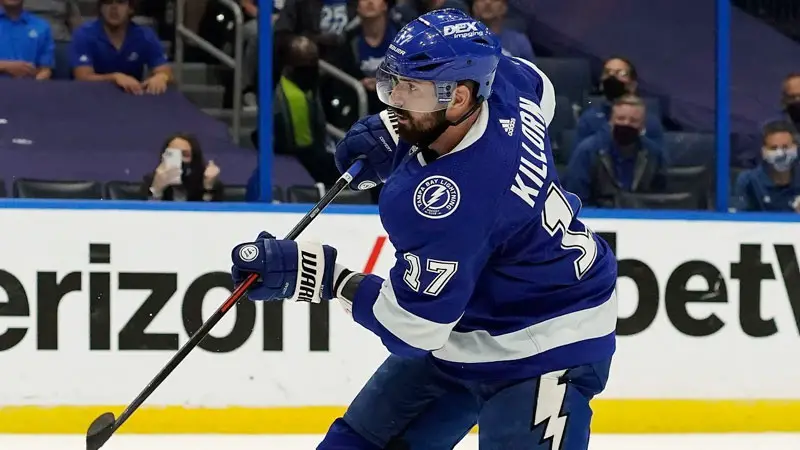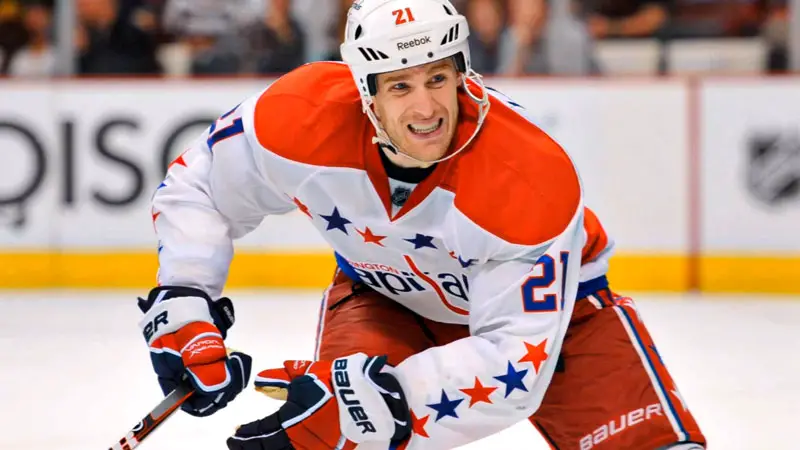Immerse yourself in the thrilling realm of fantasy hockey, a virtual landscape where hockey aficionados transform into team managers, strategically navigating the dynamic world of the NHL.
Fantasy hockey stands as a testament to the fusion of sports fandom and strategic thinking, offering enthusiasts an interactive experience unlike any other. But Fantasy hockey- how does it work?
Fantasy hockey revolves around the art of team management, where participants assemble their dream teams using real NHL players.
The core concept lies in predicting and capitalizing on player performances in actual NHL games.
From drafting a formidable roster to making shrewd in-season moves, participants engage in a season-long chess match to outmaneuver their fellow managers.
As the season unfolds, points accumulate based on the real-world achievements of the chosen players, adding a layer of excitement and strategy to each puck drop.
Let’s delve into the intricate workings of fantasy hockey, uncovering the nuances that make it a beloved pastime for sports enthusiasts and strategic minds alike. Stay sharp.
The Basics of Fantasy Hockey
Fantasy hockey is a captivating and strategic virtual sport that allows fans to manage their own teams comprised of real NHL players.
This engaging pastime provides a unique opportunity for hockey enthusiasts to showcase their managerial prowess and knowledge of the game.
To navigate the complex world of fantasy hockey effectively, it’s crucial to grasp the basics. Here are some key points to help you understand and excel in fantasy hockey:
Player Selection and Drafting
In fantasy hockey, success begins with the selection of a strong roster during the drafting process. Understanding player statistics, performance trends, and potential injuries is essential.
During the draft, participants take turns choosing players for their team, aiming to create a well-rounded lineup that covers various positions, including forwards, defensemen, and goaltenders.
A thoughtful and informed draft strategy is fundamental to building a competitive team.
Scoring System Knowledge
Each fantasy hockey league employs a specific scoring system that assigns points based on player performance. Familiarizing yourself with this scoring system is crucial for making informed decisions about your roster.
Points are typically awarded for goals, assists, and various goaltending statistics. Some leagues may also incorporate penalty minutes, power-play points, and other metrics.
Understanding how these scoring categories contribute to overall team success will help you make strategic moves throughout the season.
Player Transactions and Management
Fantasy hockey is dynamic, and successful managers stay actively involved in their team’s performance.
This involves making savvy player transactions, such as trades and free-agent acquisitions, to address weaknesses and capitalize on opportunities.
Staying informed about player injuries, line changes, and overall team dynamics is essential for making timely and effective roster adjustments.
Monitoring the NHL Schedule
The NHL schedule plays a significant role in fantasy hockey strategy. Teams have varying numbers of games each week, affecting the potential for player points.
Keeping a close eye on the schedule allows managers to optimize their lineup by starting players with more games and benching those with fewer.
This strategic approach ensures that your team consistently accumulates points and remains competitive throughout the season.
Strategic Use of Bench and Starting Lineup
An often overlooked aspect of fantasy hockey is the strategic use of your bench and starting lineup.
Understanding player matchups, recent performances, and the overall team context can help you make informed decisions about which players to start and which to place on the bench.
Maximizing the potential points from your starting lineup while strategically utilizing your bench players can be a game-changer in fantasy hockey.
League Formats of Fantasy Hockey

Fantasy hockey involves not only understanding player dynamics but also navigating the diverse landscape of league formats.
The various structures of fantasy hockey leagues cater to different preferences and intensities, offering participants a range of options to match their desired level of commitment and competitiveness.
Here are some of the key league formats that shape the fantasy hockey experience:
Season-Long Standard Leagues
Standard leagues are the bedrock of fantasy hockey, typically spanning the entire NHL season.
Participants draft their teams at the beginning and manage their rosters throughout the season, competing head-to-head with other managers each week.
Points accumulate over the season, and the team with the most points emerges victorious in this traditional and widely embraced format.
Head-to-Head (H2H) Leagues
H2H leagues pit fantasy teams against each other every week. Teams compete in various statistical categories (goals, assists, saves, etc.), earning wins or losses based on their performance relative to opponents.
The playoff format adds an extra layer of excitement, leading to a culmination where the best-performing teams face off for the championship.
Rotisserie (Roto) Leagues
Rotisserie leagues take a season-long approach, ranking teams based on cumulative statistics in various categories.
Teams earn points based on their standing in each category, and the team with the highest overall point total at the end of the season claims victory.
This format emphasizes consistency across multiple statistical dimensions.
Daily Fantasy Sports (DFS)
For those seeking a more dynamic and immediate experience, daily fantasy sports have gained immense popularity.
In DFS, participants assemble a new lineup for each day or game, staying within a designated salary cap.
This format allows for frequent team adjustments, offering a fast-paced and strategic alternative to the traditional season-long leagues.
Keeper Leagues
Keeper leagues introduce a long-term element, allowing managers to retain a set number of players from their previous season’s roster.
This adds a layer of strategy as participants must balance immediate success with building a team for sustained competitiveness.
Keeper leagues foster a sense of continuity and engagement across multiple seasons, enhancing the fantasy hockey experience.
Fantasy Hockey- How Does It Work?

Embarking on the virtual journey of fantasy hockey requires a blend of strategic acumen and a keen understanding of the game’s mechanics.
This immersive experience allows hockey enthusiasts to step into the shoes of team managers, curating a roster of real NHL players and competing based on their on-ice performances.
Let’s unravel the intricacies of how fantasy hockey works:
Player Draft and Roster Construction
Fantasy hockey begins with a crucial player draft, where participants strategically select players for their teams. Rosters typically include forwards, defensemen, and goaltenders.
The art lies in creating a well-balanced team that covers various positions while considering player performance, potential injuries, and team dynamics.
Scoring System and Point Accumulation
Understanding the league’s scoring system is paramount. Points are awarded to fantasy teams based on the real-world achievements of their chosen players.
Goals, assists, saves, and other statistical categories contribute to a team’s point total.
A mastery of the scoring system allows managers to make informed decisions, maximizing point accumulation throughout the season.
In-Season Management and Transactions
The fantasy hockey landscape is dynamic, requiring active in-season management. Managers can make strategic moves by trading players with other teams or acquiring free agents from the waiver wire.
Staying abreast of player injuries, lineup changes, and overall team performance is essential for making timely and effective roster adjustments.
Weekly Head-to-Head or Season-Long Accumulation
Leagues may follow different structures, with some employing a head-to-head format where teams compete against each other weekly, while others adopt a season-long accumulation approach.
In head-to-head leagues, teams vie for victories in specific statistical categories each week. Season-long accumulation leagues, on the other hand, focus on the overall performance across the entire NHL season.
Playoff Dynamics and Championship Pursuit
As the NHL season progresses, fantasy leagues often introduce playoffs, mirroring the intensity of the real sport.
Teams that qualify compete in a bracket-style format, with the ultimate goal of winning the championship.
Navigating the playoffs requires careful consideration of matchups and strategic roster adjustments to secure the coveted fantasy hockey title.
Scoring System of Fantasy Hockey

Each league adopts a unique set of rules to allocate points based on players’ real-world achievements during NHL games.
Delving into the intricacies of the scoring system provides a roadmap for fantasy managers to navigate their way to success:
Goal and Assist Contributions
The most fundamental elements of scoring in fantasy hockey revolve around goals and assists. Points are awarded to fantasy teams when their chosen players score goals or contribute assists during NHL games.
These basic offensive statistics form the backbone of point accumulation, rewarding managers for the offensive prowess of their roster.
Goaltending Heroics
Goaltenders play a pivotal role in fantasy hockey, and their performances are meticulously tracked. Points are often awarded for saves made, with bonuses for shutouts.
While goalies can be a source of significant fantasy points, their performances can also swing the outcome of fantasy matchups, making the strategic selection and deployment of goaltenders crucial.
Special Team Contributions
Fantasy hockey leagues often incorporate points for special team contributions. Power-play points, shorthand goals, and game-winning goals can all contribute to a player’s fantasy point total.
Understanding how players excel in these situations allows fantasy managers to identify key contributors and gain an edge in their leagues.
Penalty Minutes and Defensive Contributions
Beyond offensive and goaltending statistics, fantasy hockey leagues may award points for penalty minutes and defensive contributions.
For some managers, the inclusion of these categories adds a strategic layer, requiring consideration of players’ all-around contributions to their NHL teams.
Negative Points for Penalties and Minus Ratings
While positive contributions are rewarded, fantasy hockey leagues may also impose penalties for negative actions on the ice.
Players may incur point deductions for penalties taken, and their plus-minus ratings, indicating the goal differential when they are on the ice, can influence fantasy scoring.
This adds a dimension of risk and reward, prompting managers to balance aggressive play with discipline.
Player Selection and Strategy of Fantasy Hockey
Assembling a roster that can navigate the ups and downs of the NHL season is an art that involves careful planning and adaptability.
Let’s delve into the key aspects of player selection and strategy in fantasy hockey:
Draft Strategy and Positional Awareness
The foundation of a competitive fantasy hockey team is laid during the draft.
Managers must develop a strategic approach, considering factors such as player rankings, positional scarcity, and overall team balance.
Recognizing the depth of talent at each position and understanding when to target specific positions during the draft is crucial for building a well-rounded roster.
Player Analysis and Statistical Trends
In-depth player analysis is a cornerstone of successful fantasy hockey management. Beyond basic statistics, managers should delve into advanced metrics and recent performance trends.
Understanding a player’s role on their NHL team, power-play involvement, and historical performance against certain opponents provides valuable insights for making informed decisions throughout the season.
Injury Considerations and Risk Management
The NHL season is grueling, and injuries are an inevitable part of the game. Fantasy managers must stay vigilant about player health, considering both current injuries and injury-prone histories.
Balancing high-risk, high-reward players with more consistent contributors is a delicate task. A successful strategy involves mitigating risk by having a mix of reliable players and potential breakout stars.
Waiver Wire Acumen and In-Season Adjustments
A vigilant eye on the waiver wire is a hallmark of a skilled fantasy hockey manager.
Identifying emerging talents, players returning from injury, or those with favorable upcoming schedules can provide a competitive edge.
Successful managers remain proactive throughout the season, making strategic in-season adjustments to address roster deficiencies and capitalize on player hot streaks.
Trade Tactics and Team Dynamics
Trades are a powerful tool in fantasy hockey, allowing managers to address specific needs or capitalize on market inefficiencies.
Understanding the dynamics of your league, gauging the trade market, and recognizing when to buy low or sell high are crucial skills.
Successful trades can reshape your roster and elevate your team’s competitiveness.
Excelling in fantasy hockey requires a multi-faceted approach to player selection and strategy.
FAQs
How does drafting work in fantasy hockey?
During the draft, fantasy managers take turns selecting NHL players for their teams. The selection order is often randomized or based on the previous season’s performance.
A well-thought-out draft strategy is crucial for building a competitive and balanced roster.
What is the scoring system in fantasy hockey?
Fantasy hockey leagues have specific scoring systems that allocate points based on real-world player performances. Points are awarded for goals, assists, saves, and other statistical categories.
Understanding the scoring system is essential for making informed roster decisions and strategic moves throughout the season.
How do in-season transactions work in fantasy hockey?
In-season transactions in fantasy hockey involve actions like trading players with other teams or acquiring free agents from the waiver wire.
Staying informed about player injuries, lineup changes, and team dynamics is crucial for making timely and effective roster adjustments to enhance your team’s performance.
What is the difference between head-to-head and season-long accumulation leagues?
In head-to-head leagues, fantasy teams compete against each other weekly, earning wins or losses based on specific statistical categories.
Season-long accumulation leagues focus on the overall performance across the entire NHL season, with teams accumulating points in various categories to determine the standings.
How do playoffs work in fantasy hockey?
Fantasy hockey playoffs usually mirror the structure of the real NHL playoffs. Teams that qualify compete in a bracket-style format, with the best-performing teams advancing to subsequent rounds.
Successful navigation of the playoffs, with strategic roster adjustments, is crucial for clinching the fantasy hockey championship.
Wrapping Up
In the enthralling universe of fantasy hockey, success hinges on a manager’s strategic finesse and understanding of the game’s nuances.
From the intricacies of drafting to mastering the scoring system, each decision shapes the journey.
A thoughtful player selection strategy, coupled with active in-season management, creates a dynamic and immersive experience.
As leagues unfold, the quest for the championship demands adaptability, a keen eye on the waiver wire, and astute trade tactics.
Fantasy hockey is not merely a virtual sport but a strategic odyssey where enthusiasts craft their path to glory, mastering the art of team management on the digital ice. Thank you so much.





James Felix